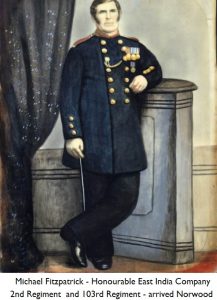The Enrolled Pensioner Guards Special Interest Group of FamilyHistoryWA was founded by descendants of men who came to Western Australia as guards on convict ships during the years of transportation to Western Australia, 1850-1868. To ensure the safety of the convict ships each ship had a guard consisting of men who had been pensioned off from the British Army, Royal Marines and the East India Company or, on several ships, serving soldiers. Another two ships bought additional men after the cessation of transportation.
 The average citizen was opposed to transportation on the grounds of public safety. So it was proposed that any convict sent would be well behaved, have served most of his sentence and be entitled to a ticket-of-leave on, or soon after his arrival.
The average citizen was opposed to transportation on the grounds of public safety. So it was proposed that any convict sent would be well behaved, have served most of his sentence and be entitled to a ticket-of-leave on, or soon after his arrival.
However, over time, the convicts became much more hardened criminals, that necessitated the building of Fremantle Prison.
Thirty seven ships brought 1,248 individual Pensioner Guards to Western Australia between 1850 and 1874, another 7 military men have also been identified as serving with the Enrolled Force – making 1,255 men in total.
As an enticement to volunteer as a Convict guard each man was offered a free passage for himself, his wife and children, guaranteed employment for a limited period after arrival and to those eligible, a land grant and a two-roomed cottage to which they would be entitled to Fee Simple after seven years occupancy and making general improvements.
After the cessation of transportation to Western Australia in 1868 the role played by EPGs decreased. In 1874 the Colonial Office instructed the Staff Officer of Pensioners to reduce the level of expenditure until finally on the 10th November 1880, the Force was officially disbanded. Guards were still required for Government House, the magazine, and the Fremantle prison and in addition a member of the guard was appointed as an orderly for the Governor. As a temporary measure, it was decided to form an Enrolled Guard under the command of the Commissioner of Police to be disbanded on 31 March 1887.
The employment of EPGs had many advantages in that there was increased money flowing into the economy through the payment of pensions and wages. Expenditure increased with the erection of the Fremantle Prison and Pensioner Barracks at both Fremantle and Perth as well as roads and bridges, much of it paid for by Imperial funds.
WEBSITE BACKGROUND
Many dedicated members have allowed us to build a significant body of research:
- The Formation of the EPG SIG by Jean McDonald 2003 EPG Gazette 2015
- Vale Ron Sutton by Jean McDonald 2009 October EPG Gazette
- Vale Jean McDonald – EPG Gazette July 2019
F. H. (Frank) Broomhall’s seminal 1985 book The Veterans A History of the Enrolled Pensioner Force in Western Australia, 1850-1880 has been the cornerstone of research into the EPGs.
M.S. James’s outstanding research in her 2016 book A Superior Body of Men built on Broomhall’s research and for first time enabled us to make a more accurate account of the men on ships for which no list of the guard was available.
To extend the scope of these we launched this website in 2018 to focus on EPGs and where possible their families. Online publication of the service records (WO97), pension district payment records (WO22) and the Regimental pensioner registers (WO23) enabled us to identify nearly all the men we know came to Western Australia as EPGs.
The research for the website was initially established in 2011 under the direction of the “Ships Project” and its “Admiral” Margaret Hickey, who directed a group of researchers known as “Ships Captains” to build a profile for each EPG and wherever possible, their parents, siblings, spouses and children.
The most significant and widely used resources and references to develop and present the information on the website include the following:
- Barker D. Warders and Gaolers WAGS 2000
- Broomhall F.H. The Veterans: a history of the Enrolled Pensioner Force in Western Australia 1850-1880 Hesperian Press Western Australia 1985
- Erickson R. The Bicentennial dictionary of Western Australians pre-1829 – 1888 UWA Press 1888
- James M.S. A superior body of men Authorhouse 2016
- War Office documents – WO10, WO12, WO97, WO22, WO23, WO100
Other more specific references were also used which are more related to individual profiles.
THANKS
Thanks to all who participated in developing and researching EPGs. Special thanks go to Margaret Hickey and her Captains – Pam Anspach, Ian Barnes, Marjorie Burton, Noel Donegan, Liana Fitzpatrick, Teresa Handcock, Tom Joynes (deceased), Kaye Kelly, John Knowles, Ken Lance (deceased), Greg Larsen, Jeanette Lee, Marilyn McCutcheon, Sally Nicholas, Diane Oldman, Gillian O’Mara, Peter Short, Beth Smith & Glen Stevenson.
